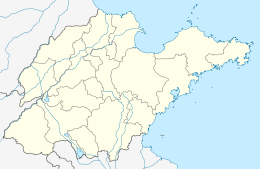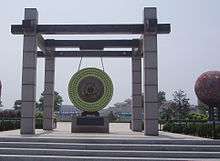Penglai, Shandong
| Penglai 蓬莱市 | |
|---|---|
| County-level city | |
|
Penglai City viewed from the Penglai Pavilion | |
 Penglai Location in Shandong | |
| Coordinates: 37°49′N 120°44′E / 37.817°N 120.733°ECoordinates: 37°49′N 120°44′E / 37.817°N 120.733°E | |
| Country | People's Republic of China |
| Province | Shandong |
| Prefecture-level city | Yantai |
| Area | |
| • Total | 1,128.5 km2 (435.7 sq mi) |
| Population (2003) | 447,000 |
| Time zone | China Standard (UTC+8) |
| Postal code | 265600 |
| Area code(s) | 0535 |
| Website |
penglai |
| Penglai | |||||||||
| Simplified Chinese | 蓬莱 | ||||||||
|---|---|---|---|---|---|---|---|---|---|
| Traditional Chinese | 蓬萊 | ||||||||
| |||||||||
| Former names | |||||||||
| Dengzhou | |||||||||
|---|---|---|---|---|---|---|---|---|---|
| Chinese | 登州 | ||||||||
| Postal | Tengchow | ||||||||
| |||||||||
Penglai, formerly known as Dengzhou or Tengchow,[lower-alpha 1] is a county-level city belonging to the prefecture-level city of Yantai, Shandong Province, in the People's Republic of China. It lies on the northwest corner of the Shandong Peninsula on the southern coast of the Gulf of Bohai. The city is famous for its mirages out at sea, which are frequent during May and June.
Geography
Penglai is entirely surrounded by other divisions of Yantai: Fushan District is to the east, Longkou City to the west, and Qixia City to the south. Its limits in geographic coordinates are 37° 25'–37° 50' N, 120° 35'–121° 09' E.
History
The Red Cliffs (丹崖) of the area are reputed to have been the site where the Eight Immortals set out for the land of the immortals and where the First Emperor (Shi Huangdi) later sent off five hundred boys and five hundred girls on ships to search for them. Chinese legends held that a mystic dolphin was seen from the cliffs above and, missing it with his spear, the emperor knew that his days were numbered. The Martial Emperor of Han (Han Wudi) later also visited the area while searching for the elixir of immortality.
The old city walls incorporate guard towers of three stories (rather than the usual two) because the uncle of the first emperor of the 6th-century Sui dynasty had been prince of the area.[3] Under the Ming, the harbor was fortified and used by the warjunks of the imperial navy.
Following the Second Opium War, Dengzhou became the first port opened to foreigners on the Shandong Peninsula in 1858.[1][4] Christian missions were quickly established.[4] The harbor was found inadequate for the traders, however, and Zhifu (now central Yantai) was developed 30 miles (48 km) away to function as Dengzhou's port.[1]
Administration

The city contains seven townships (镇), five subdistricts (街道), and three development zones (区):
- Beigou Town (北沟镇): contains Xicheng Port Industrial Park (西城临港工业区)
- Chaoshui Town (潮水镇)
- Cunli Town (村里集镇)
- Daliu Town (大柳行镇): contains a namesake industrial park
- Daxindian Town (大辛店镇)
- Dengzhou Subdistrict (登州街道): where Qin Shi Huang reputedly visited to gain immortality
- Liujiagou Town (刘家沟镇)
- Nanwang Subdistrict (南王街道)
- Penglai Economic Development Zone (蓬莱经济开发区): contains three industrial parks
- Penglai Tourism-Vacation Area (蓬莱旅游度假区)
- Penglai Urban District (蓬莱城区)
- Penglaige Subdistrict (蓬莱阁街道)
- Xiaomenjia Town (小门家镇)
- Xingang Subdistrict (新港街道)
- Zijing Subdistrict (紫荆山街道)
Together, the three qu (zone, district, and area) co-exist with the coastal Xingang Subdistrict.
Economy
374,400 Penglai citizens work in agriculture, with the remaining 75,600 in various other sectors.
Tourism

Penglai has been ranked by the Chinese government as a top domestic tourist destination.[5] Its Water Fortress (水城, Shuíchéng), a fortified harbor, is one of China's oldest military ports. It was built under the Ming in 1376[6] and housed a fleet of warjunks.[3] It is now a protected historical monument being renovated at a cost of 500m RMB (more than $60m). There is a plank walk along the cliffs nearby.
More than US$25 million has also been invested into developing the Penglai Pavilion and other sites. The Penglai Pavilion is a large park of ancient buildings, palaces and temples, that have been restored and rebuilt. It has been a tourist goal for more than a thousand years, and the site features inscriptions from famous poets and calligraphers like Su Shi and Dong Qichang. Among other cultural attractions of Penglai are the Naval Museum with exhibits of ancient ships and the restored residence of the famous patriotic general Qi Jiguang. Penglai also has the largest ocean aquarium in Asia. It includes a polar area, a shark hall, a tropical rainforest, and a theater with mermaids, dolphins and sea lions.[7] A picturesque festival takes place in January for the birthday of Tianhou, a local sea goddess.
While tourism is the mainstay of Penglai’s economy, bringing more than two million tourists annually, in fact the entire center of the town around the harbour was walled off and completely razed in 2006.[8]
Wine industry
The production of wine is the second largest industry in the province. Agriculture is first. However, in Penglai, tourism is the primary industry, and wine-making is second. The hills south of Penglai have an average elevation of 200 metres (660 ft), while the coastal areas are relatively flat. Most of the soil is loose, well-aerated, and rich in minerals and organic matters that enable full development of the root systems. The wineries are located mainly in the Nanwang Grape Valley and along the Yan-Peng Sightseeing Highway. The main varieties grown there, like Cabernet Sauvignon, Cabernet Gernischt, Merlot, Riesling and Chardonnay, are all reaching 20 years of age, considered to be the golden stage for these grapes. Most of them maintain an average sugar content of above 20%. The Cabernet is especially typical, with good color and a dense fragrance.
Notable residents
- Qi Jiguang (戚继光, 1528-1588) Ming Dynasty general and national hero who fought Japanese pirates
- Henry Luce (1898–1967) - born in Penglai, founder of TIME, Fortune, and Life.
- Ida Pruitt (1888–1985) - born in Penglai, spoke fluent Chinese, prolific writer on China
- Wu Peifu (吴佩孚, 1874–1939) - army general, later became one of the most powerful military rulers in China during the Warlord Era (1916–1928)
- Meng Xuenong (simplified Chinese: 孟学农; traditional Chinese: 孟學農; pinyin: Mèng Xuénóng 1949- ) - vice-governor and acting governor of Shanxi (as of 2007) and disgraced former Mayor of Beijing Municipality
See also
Notes
References
Citations
- 1 2 3 EB (1878).
- ↑ EB (1911), p. 132.
- 1 2 Pruitt, Ida, A Daughter of Han.
- 1 2 Brown, Arthur Judson (1904) New forces in old China: an unwelcome but inevitable awakening F.H. Revell Co., New York, Chapter IV OCLC 2177558
- ↑ http://www.penglai.gov.cn/en/tzxm/index_show.jsp?id=1001&code=EN_I_TOURISM&name=Tourism
- ↑ China Daily article on Penglai Water City
- ↑
- ↑ "Penglai Destroyed".
Bibliography
- "Che-foo", Encyclopædia Britannica, 9th ed., Vol. V, New York: Charles Scribner's Sons, 1878, p. 455.
- "Chi-fu", Encyclopædia Britannica, 11th ed., Vol. VI, Cambridge: Cambridge University Press, 1911, pp. 132–3.
External links
- 中国蓬莱 (Penglai, China): official municipal government (in Simplified Chinese)
- Rare Mirage Lasts for 4 Hours off East China Shore
- Cultural and tourist information about Penglai
- Attractions of the Penglai Pavilion area
- Article about a visit to Penglai
- Article describing the Water City

